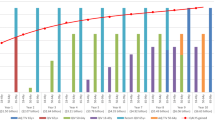Abstract
The Recommended Childhood Immunization Schedule has become sufficiently crowded that the prospect of adding additional vaccines to this schedule may not be well received by either health-care providers or parents/guardians. This has encouraged vaccine manufacturers to develop combination vaccines that can permit new vaccines to be added to the schedule without requiring children to be exposed to an unacceptable number of injections during a single clinic visit. This paper develops an integer programming model to assess the economic premium that exists in having combination vaccines available. The results of this study suggest that combination vaccines provide a cost effective alternative to individual vaccines and that further developments and innovations in this area by vaccine manufacturers can provide significant economic and societal benefits.
Similar content being viewed by others
References
R.L. Burden and J.D. Faires, Numerical Analysis, 6th ed. (Brookes-Cole, New York, 1997).
CDC, Recommended childhood immunization schedule – United States, July–December 1996, The Morbidity and Mortality Weekly Report 45(29) (1996) 635–638.
CDC, Combination vaccines for childhood immunization, The Morbidity and Mortality Weekly Report 48(RR05) (1999) 1–15.
CDC, Notice to readers: Recommended childhood immunization schedule – United States, 2000, The Morbidity and Mortality Weekly Report 49(2) (2000) 35–38,47.
CDC, Preventing pneumococcal disease among infants and young children, The Morbidity and Mortality Weekly Report 49(RR09) (2000) 1–38.
V.J. Dietz, J. Stevenson, E.R. Zell, S. Cochi, S. Hadler and D. Eddins, Potential impact on vaccination coverage levels by administering vaccines simultaneously and reducing dropout rates, Archives of Pediatric and Adolescent Medicine 148 (1994) 943–949.
S.H. Jacobson, E.C. Sewell, R. Deuson and B.G. Weniger, An integer programming model for vaccine procurement and delivery for childhood immunization: a pilot study, Health Care Management Science 2(1) (1999) 1–9.
M. Kuppermann, R.F. Nease Jr., L.M. Ackerson, S.B. Black, H.R. Shinefield and T.A. Lieu, Parents' preferences for outcomes associated with childhood vaccinations, Pediatric Infectious Disease Journal 19 (2000) 129–133.
C.T. Le, Combination vaccines: Choices or chaos: A practitioner's perspective, Clinical Infectious Diseases 33(4) (2001) s367–s371.
C.W. LeBaron, L. Rodewald and S. Humiston, How much time is spent on well-child care and vaccination? Archives of Pediatrics and Adolescent Medicine 153 (1999) 1154–1159.
T.A. Lieu, S.B. Black, G.T. Ray, K.E. Martin, H.R. Shinefield and B.G. Weniger, The hidden costs of infant vaccination, Vaccine 19(1) (2000) 33–41.
D. Madlon-Kay and P. Harper, Too many shots? Parent, nurse and physician attitudes toward multiple simultaneous childhood vaccinations, Archives of Family Medicine 3 (1994) 610–613.
A.S. Meyerhoff, B.G. Weniger and R.J. Jacobs, The economic value to parents of reducing the pain and emotional distress of childhood vaccine injections, Pediatric Infectious Disease Journal 20(11) (2001) s57–s62.
P.D. Parkman, Combined and simultaneously administered vaccines: A brief history, in: Combined and Vaccines and Simultaneous Administration: Current Issues and Perspectives, Annals of the New York Academy of Sciences, Vol. 754 (New York Academy of Sciences, New York, 1995) pp. 1–9.
E.C. Sewell, S.H. Jacobson and B.G. Weniger, Reverse engineering a formulary selection algorithm to determine the economic value of pentavalent and hexavalent combination vaccines, Pediatric Infectious Disease Journal 20(11) (2001) s45–s56.
J. van Hoof, Perspectives on the manufacture of combination vaccines, Clinical Infectious Diseases 33(4) (2001) s334–s339.
J.R. Vose, Manufacturing issues related to combining different antigens: An industry perspective, Clinical Infectious Diseases 33(4) (2001) s346–s350.
B.G. Weniger, Economic analysis to meet the challenges of new and combination vaccines, Presented at Vaccine Economics: Planning a Research Agenda for the Challenge of New and Improved Vaccines, Atlanta, GA (December 18, 1996).
B.G. Weniger, R.T. Chen, S.H. Jacobson, E.C. Sewell, R. Deuson, J.R. Livengood and W.A. Orenstein, Addressing the challenges to immunization practice with an economic algorithm for vaccine selection, Vaccine 16(19) (1998) 1885–1897.
Author information
Authors and Affiliations
Rights and permissions
About this article
Cite this article
Sewell, E.C., Jacobson, S.H. Using an Integer Programming Model to Determine the Price of Combination Vaccines for Childhood Immunization. Annals of Operations Research 119, 261–284 (2003). https://doi.org/10.1023/A:1022955111568
Issue Date:
DOI: https://doi.org/10.1023/A:1022955111568




